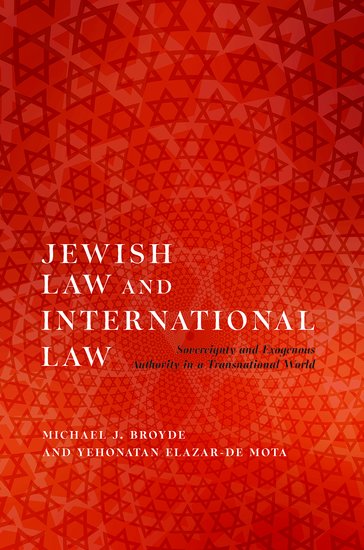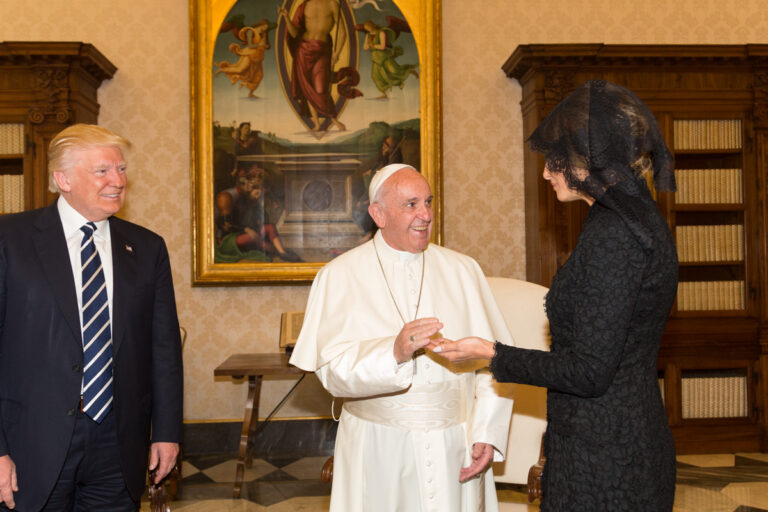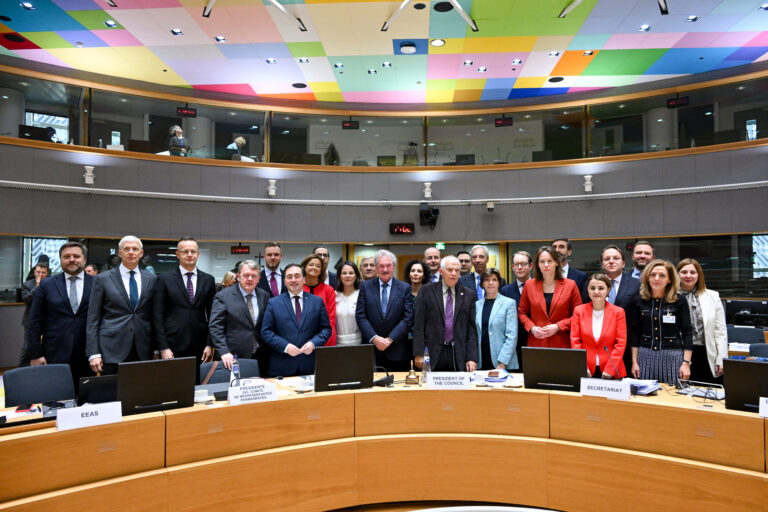
Jewish Law Meets International Law
Michael J. Broyde and Yehonatán Elazar-De Mota
The following is an introduction to Michael J. Broyde and Yehonatán Elazar-De Mota’s new book, Jewish Law and International Law: Sovereignty and Exogenous Authority in a Transnational World (Oxford, 2025).
In today’s interconnected world, legal traditions are constantly interacting across borders. Nations craft treaties that bind multiple countries, international courts address issues that span continents, and communities navigate both local laws and global norms. In this context, religious legal traditions—some of which have guided communities for millennia—are increasingly relevant in shaping and responding to international law. How do age-old religious laws engage with modern principles that govern the international community? Can a religious legal system, which originated in antiquity, speak to questions of war, human rights, or global governance? These questions lie at the heart of our book, Jewish Law and International Law: Sovereignty and Exogenous Authority in a Transnational World (Oxford, 2025).

Our work offers a timely exploration of the intricate relationship between Jewish law (Halakhah) and international legal systems. Its significance is underscored by current events: we live in an era marked by rising antisemitism and increasing tensions between the State of Israel and the international legal community. These challenges highlight the need for a deeper understanding of how Jewish law perceives and contributes to the broader legal landscape. At the same time, as global legal interactions intensify, international law is looking more closely at moral and religious perspectives in areas like human rights and humanitarian issues. Our book provides insight into how a major religious legal tradition can both shape and be shaped by international law in our transnational world.
Overview: Comparing Legal Systems
Jewish Law and International Law is organized into eight chapters that weave together historical, legal, and comparative analysis. We begin by laying a foundation, introducing readers to the basics of Jewish law (Halakhah) and international law, and highlighting a striking commonality: both are legal systems that transcend territorial boundaries. Neither Jewish law nor international law is confined to a single country’s borders—Halakhah has governed the Jewish people across many lands, and international law operates above individual nations. This sets the stage for a rich exploration of how these two systems have interacted and paralleled one another over time.Our work examines several key themes at the intersection of Jewish and international law:
- Foundational Relationship: We discuss how Jewish law (Halakhah) and international law relate to one another, revealing significant jurisprudential and methodological parallels. Both legal systems claim authority beyond any single sovereign state—Jewish law, grounded in divine mandate, applies to Jews globally, while international law derives authority from agreements between states and shared global norms. This foundational section shows that, despite their different origins, Halakhah and international law share a transnational character and a commitment to universal principles.
- Historical Incorporation of External Norms: A major theme of our book is how Jewish law has historically incorporated norms from outside legal systems. For centuries, Jewish communities lived under various empires and nations, developing doctrines to integrate local law into Halakhah. For example, the Talmudic principle of “Dina de-Malkhuta Dina” (“the law of the land is the law”) allowed Jews to recognize the binding nature of a host country’s laws in many civil matters. This historical perspective shows that Halakhah was never an isolated system; it continually interacted with secular authority. When appropriate, Jewish law even acknowledged treaties and international agreements as sources of obligation. Classical sources prohibited breaching treaties, viewing such violations as not only politically detrimental but also as transgressions against divine command. This historical approach provides context for understanding how Halakhah might engage with modern international law.
- Case Studies in War and Humanitarian Law: One of the most compelling sections of our book delves into the laws of war and humanitarian principles from a Jewish legal perspective. War and peace are classic subjects of international law—governed today by instruments like the Geneva Conventions—and we ask how Jewish law’s own rules compare. Jewish legal tradition contains an ancient but evolving set of ethical guidelines for warfare that closely mirror many modern humanitarian norms. We explore how contemporary Jewish law authorities have often embraced international humanitarian law standards. For instance, some modern rabbis argue that because Halakhah does not offer an exhaustive code on modern warfare, secular international norms effectively fill that role for a Jewish state. By examining these parallels, our work shows that Halakhah can support and even reinforce global standards of humane conduct during conflict.
- Case Study in Copyright Law: In another illustrative chapter, we turn to intellectual property, specifically copyright law, through a Jewish legal lens. Copyright might seem like a modern legal invention, yet Jewish law has long grappled with similar issues. We trace how, long before modern states enacted copyright statutes, Jewish communities enforced restrictions on unauthorized copying of texts. A notable case from the sixteenth century involved rabbinic efforts to prevent the unauthorized reprinting of a legal code, thereby establishing early principles of copyright protection. This example illustrates how Halakhah developed mechanisms to safeguard creative works, aligning well with modern international copyright norms through the principle of recognizing the “law of the land.”
- Jewish Law in the Modern International Order: Our book also examines how Jewish legal thought responds to contemporary challenges. In an age of global institutions like the United Nations and international treaties, we analyze how Jewish law guides the behavior of modern Jewish communities and the State of Israel. Even though Halakhah today is not the state law (except partially within Israel’s religious courts), it still provides essential guidance for interactions with secular legal regimes. Our analysis illustrates that by embracing certain external legal obligations, Jewish law helps ensure that communities remain both faithful to tradition and engaged with modernity.
- Jewish Law and Antisemitic Legal Systems: A particularly poignant chapter in our work addresses how Jewish law has historically navigated hostile legal systems. From the decrees of ancient empires to the oppressive laws of the medieval period and even to the modern era, Jewish communities have often faced legal systems that discriminated against them. We explore how Halakhah provided guidance on when to comply with or resist unjust laws, a debate that remains relevant as antisemitism continues to pose challenges worldwide.
Kindred Spirits: Transcending Territoriality, Incorporation without Compromise
Our central argument is that Jewish law and international law are, at their core, kindred spirits. Both systems extend beyond territorial limitations and engage with universal principles that shape collective life. International law, by its nature, operates above the level of individual states, while Jewish law has historically served a dispersed people, governing their lives regardless of geography. This transnational character is crucial for understanding the enduring relevance of Halakhah.
We also argue that both legal systems have developed robust mechanisms to incorporate external authority without compromising their core identities. The principle of Dina de-Malkhuta Dina illustrates how Jewish law embraces the local, secular law as part of its framework. When a Jewish community or state enters into a treaty, the agreement is not merely a political contract—it carries a religious obligation to honor it. This idea is central to our analysis of how Jewish law incorporates international commitments, such as Israel’s treaty obligations under the Geneva Conventions.
Another important contribution of our book is the detailed comparative approach we adopt. Rather than treating Jewish law and international law as separate or incompatible, we juxtapose them to reveal both common ground and productive tensions. In areas such as warfare and intellectual property, we demonstrate that Jewish legal principles align closely with modern international norms. This comparison not only enriches the scholarly dialogue but also invites a broader audience to see Jewish law as a dynamic, adaptive system capable of engaging with contemporary challenges.
In essence, our work argues that the dialogue between Halakhah and international law is not merely academic. It has practical implications for understanding how communities can balance the preservation of tradition with the demands of an interconnected global society. By showing how Jewish law has historically managed to incorporate external legal norms—whether in the form of local municipal law or global treaties—we highlight a model of integration rather than isolation.
Jewish Law as a Living Legal System
Our book’s strengths lie in its balanced and accessible treatment of complex issues. We aim to show that Jewish law is not an isolated relic of the past but a living legal system that has continuously interacted with and adapted to secular legal environments. One of our key goals was to demystify Halakhah for readers who might otherwise view it as archaic or irrelevant. By comparing it with the widely recognized principles of international law, we hope to make clear that many of the values embedded in Jewish law—such as justice, ethical conduct in warfare, and respect for agreements—are universally applicable.
We acknowledge that some critics might argue that our approach glosses over internal debates within Halakhah, particularly regarding the limits of incorporating secular law. Indeed, there are traditional voices within the Jewish legal community that are more cautious about adopting external norms. While our book predominantly highlights instances where Jewish law has successfully integrated international principles, we also note areas where tension and debate continue. Future research might further explore these internal disagreements, providing a richer, more nuanced picture of Halakhah’s evolution.
Another area open to further discussion is the application of our insights beyond Judaism. While our focus is specifically on Jewish law, we believe that similar principles may be at work in other religious legal systems, such as Islamic law or even elements of Catholic canon law. Although such comparative work is beyond the scope of our current study, we hope that our book will serve as a springboard for broader interdisciplinary dialogue on the intersection of religious and international legal norms.
Importantly, our work has practical implications. In an era where international legal frameworks often struggle to enforce norms due to the lack of a central authority, the Jewish model—where trust and mutual respect among communities help ensure compliance—offers valuable lessons. In our view, the successes and challenges of Jewish law in incorporating external norms can inform modern discussions about global governance, human rights, and the enforcement of international law. As nations and communities face complex global challenges, our analysis suggests that a model based on mutual commitment rather than coercion might prove more sustainable and just.
Conclusion: Coexistence and Cooperation
Jewish Law and International Law: Sovereignty and Exogenous Authority in a Transnational World presents a comprehensive, accessible, and hopeful exploration of how a centuries-old religious legal system continues to engage with modern international norms. Our work demonstrates that Jewish law—far from being anachronistic—shares deep affinities with international law in its transnational reach, its reliance on treaties and customary practice, and its commitment to justice and ethical governance.
We invite readers to consider that the dialogue between Halakhah and international law is not merely a niche academic subject. Rather, it offers insights for anyone concerned with how legal systems can coexist and cooperate in our globalized world. By highlighting shared values such as respect for the rule of law, the importance of honoring agreements, and the need for ethical frameworks in conflict and commerce, we hope our book encourages a more inclusive, cooperative vision for the future.
In a time when international legal institutions are being tested and when religious communities continue to navigate complex relationships with secular authorities, our work stands as a reminder that ancient wisdom and modern law are not at odds. Instead, they can inform and enrich one another, contributing to a world where justice is not confined by borders but is a truly universal pursuit. ♦

Michael J. Broyde is a Professor of Law, the director of its SJD program, the Berman Projects Director in the Center for the Study of Law and Religion ant and a Professor of Jewish Law at the Tam Institute of Jewish Studies, all at Emory. He is also an adjunct professor of Law at Columbia University School of Law, where he teaches advanced Jewish Law.

Yehonatán Elazar-De Mota is a Senior Research Fellow at the Center for the Study of Law and Religion at Emory University’s Law School. He holds a master’s degree in Anthropology and Religious Studies from Florida International University and a PhD in International Law from the University of Amsterdam. He is rosh yeshiba of Beth Midrash Eleazar and judge (ab beth din) of Beth Din Zedek of the Dominican Republic.
Recommended Citation
Broyde, Michael J. & Yehonatán Elazar-De Mota. “Jewish Law Meets International Law.” Canopy Forum, March 28, 2025. https://canopyforum.org/2025/03/28/jewish-law-meets-international-law/.
Recent Posts










